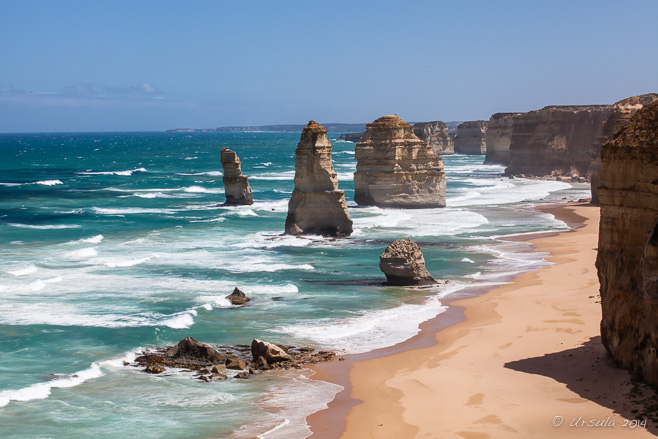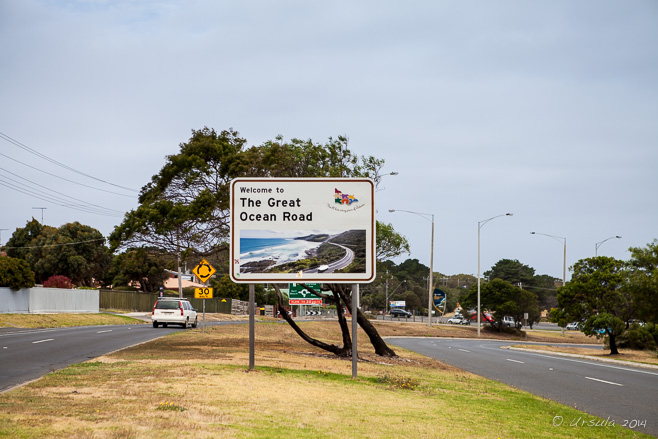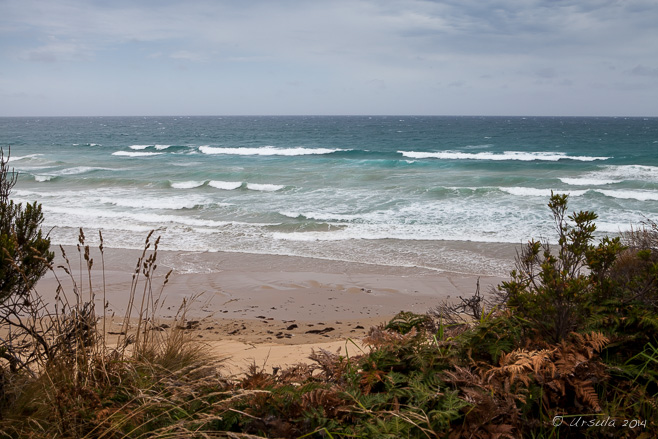
The Twelve Apostles
Crumbling limestone stacks rise dramatically out of the Southern Ocean off the Port Campbell National Park, Victoria, Australia.
The writers at the Lonely Planet call it: “one of the world’s most spectacular coastal drives”.
They are not wrong.
Officially starting in Torquay, gateway to Victoria’s “Surf Coast”, and hugging the rugged coastline along the Southern Ocean for 243 kilometres (151 miles) to Allansford, just outside the Victorian regional centre of Warrnambool, The Great Ocean Road is worthy of its listing as an Australian National Heritage site.

Ocean Road Sign, Torquay
After almost two hours of driving suburban motorways, it was a relief to finally reach a signpost for the Great Ocean Road – even if the immediate surrounds seemed inauspicious.
Torquay boasts a “Surf World Museum”, but as we had only three days in which to cover a suggested five-day itinerary from Melbourne to Adelaide, we stopped only long enough to pick up some maps, brochures, and lunch, before heading to our first (of many) beach stops.

Bell’s Beach
Waves were rolling in, but not a soul was riding them. Bell’s Beach is a renowned surf beach. I don’t surf, but I’ve seen Bell’s Beach tee-shirts as far away as Indonesia.

Lagoon, Aireys Inlet
From another car park, it’s a short walk along a sandy lagoon…

Split Point Lighthouse
… and up to the lighthouse affectionately known as the ‘White Queen’.

Split Point Lighthouse
As is fitting for a lighthouse visit, the skies were grey, and scattered rains fell. This lighthouse featured in Round the Twist, a popular children’s show that was never missed in our house.

Eagle Rock
From the lighthouse surrounds, there are views over the dramatic coastline around Aireys Inlet.
Listed as the world’s largest war memorial, the Great Ocean Road is remarkable for more than just its magnificent scenery. Built by some 3000 returned First World War Australian soldiers and sailors (“Diggers”) between war’s end and 1932, the road served as both a means of employing returned servicemen, and as a tribute and memorial to their fallen comrades.

The Diggers by Julia Squires
At the Memorial Arch, a statue commemorating “The Diggers” who built the road was unveiled in 2007.

Seagull
There is no better place to find fresh fish and chips than on a harbour where the boats come in. We stopped for an early dinner at the waterside in Apollo Bay.

Last Light
We tucked in for the night at Cape Otway Lightstation, at the southern-most point in the Cape Otway National Park.

Cape Otway Lightstation
Operating from 1848, Cape Otway is the oldest surviving lighthouse on mainland Australia.

Bicycle
Although decommissioned in January 1994, the Lightstation and grounds are open for exploration and tours.

Cape Otway Desk
Historical and other informative displays are mounted in the various well-maintained cottages.

Koala
While driving the 12 km back from the Cape Otway Lightstation through the Cape Otway National Park to rejoin the Great Ocean Road, we saw our first wild koalas in the tree-tops.

Koalas
Remarkably hard to spot from the ground through the gum-tree branches and foliage against the bright morning sky, most of the koalas seem to be asleep. Their fur and funny faces make them look cute and cuddly, but the same claws that keep them from falling out of trees can inflict nasty injuries.

Gibson Steps
Descending the 86 steep stairs to the bottom of the Gibson Steps affords a fabulous view, from the beach up, of looming rock stacks – a taste of what is to come.

Incoming Waves
The colour of the Southern Ocean as it laps onto the beach at Gibson Steps is remarkable…

Cliff Face
… as are the striations on the steep cliff-face behind us.

Next Stop: The Twelve Apostles
It seems there never were twelve rock stacks – but little matter! They are magnificent, and easily accessible from the car park.

Twelve Apostles
The coastline and rock formations seem to stretch for ever, and the walkways follow…

Twelve Apostles
… providing breathtaking views in both directions.

The Loch Ard Gorge Area
Just ten minutes further along the “Shipwreck Coast”, still in Port Campbell National Park…

The Loch Ard Gorge Area
… there are more carparks, more walkways, and more stunning views.

Loch Ard Gorge
Loch Ard Gorge is named for the clipper Loch Ard, one of many ships wrecked in the area.

Breakers
The Loch Ard ran aground on nearby Muttonbird Island in 1878. The two survivors (from 54 passengers aboard) made it into this cove, and somehow one of them, 15 year old Tom Pearce, climbed out of the gorge to get help. Watching the waves break, both inside and outside the cove, and looking up at the steep walls of the gorge, it seems an impossible feat.
We, of course, had the benefit of another steep, narrow, staircase – but even then, the assent out of the gorge felt like hard work.
There were countless other paths to follow, and both inland and coastal areas to explore, but we had, sadly, run out of time. We continued our drive west, and didn’t even see a marker when we left the magnificent Great Ocean Road behind us at the other end.

But we now know what to look out for, and when we have more time, we’ll be back…
Until next week ~
Safe Sailing!
Pictures: 3-4February2014





























.png)


Nice pictures Ursula. I’ve been meaning to get back down that way myself, you’ve just reminded me why I should. 🙂
Thanks, Kevin!
It’s a day’s driving closer for you; no excuse not to visit, really. 😀
[…] in the earth’s layers to produce these sea stacks. We were reminded of our visit to the “Twelve Apostles” in southern Australia earlier in the […]
[…] had just driven the length of Australia’s Great Ocean Road, a drive through scenery so magnificent that it rates its own UNESCO World Heritage listing. […]
thank you
Cheers!
[…] Year 4 St Vincents ursulasweeklywanders.com […]
[…] – mostly because of habitat loss, and I’ve only ever seen them once in the wild (see: The Great Ocean Road). Even in zoos they can hide, so it was nice to get so close to these balls of […]